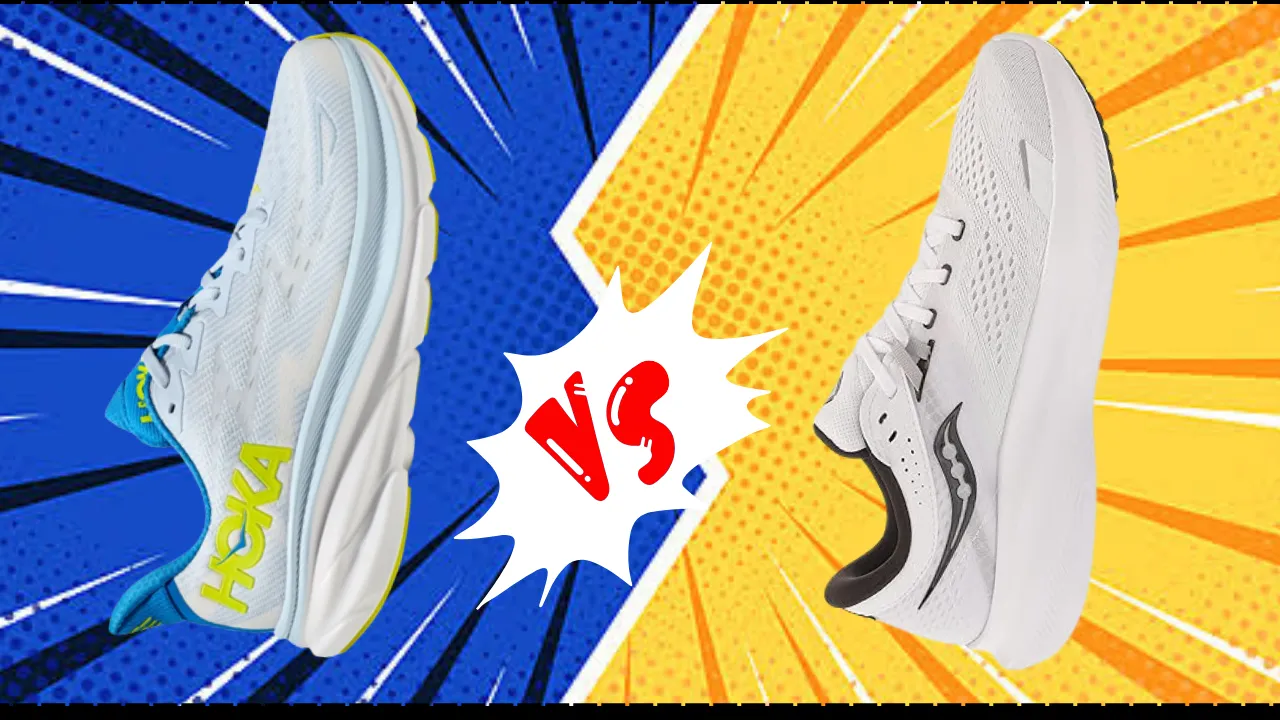The Hoka One One Clifton and the Saucony Ride are two of the most popular neutral daily training shoes on the market. The Clifton 9 and Ride 16 are the latest versions of these shoes.
If you’re trying to decide between these two models, read on for a detailed comparison of features, performance, and comfort. We’ll help you determine which shoe is the better choice for your training needs.
Similarities And Differences Between Hoka Clifton 9 And Saucony Ride 16:
| Features | Hoka Clifton 9 | Saucony Ride 16 |
|---|---|---|
| Launched In | 2023 | 2023 |
| Stability | Neutral | Neutral |
| Flexibility | Moderate | Moderate |
| Sizing | Men’s 7-13, Women’s 5-11 | Men’s 7-13, Women’s 5-11 |
| Weight | 8.8 oz (M), 7.5 oz (W) | 9.2 oz (M), 7.9 oz (W) |
| Cushion | High | Moderate |
| Outsole | Rubber | XT-900 Rubber |
| Midsole | CMEVA Foam | PWRRUN Foam |
| Upper | Mesh | Mesh |
| Retail Price | $145 | $140 |
Features Comparison:
Comparing features is a right thing before making any purchase. So considering that in mind we are going to compare features of Clifton 9 and Ride 16 to see who outperforms.
Materials:
The Clifton 9 features a thick CMEVA foam midsole which provides soft, pillowy cushioning. The mesh upper is breathable. The high-abrasion rubber outsole is durable.


The Ride 16 has a PWRRUN foam midsole that is softer than some previous Ride versions but still firm. The engineered mesh upper enhances breathability. The XT-900 rubber outsole offers excellent traction.
Durability:
Testers found the Clifton 9 to be quite durable, lasting over 300 miles for some runners. The ample rubber outsole shows minimal wear. The Ride 16 also scores well in durability, with the XT-900 rubber outsole holding up nicely to abrasion. The PWRRUN foam maintains its cushioning and responsiveness longer than prior Saucony midsole foams.
Both shoes should provide at least 300-400 miles of use for most runners. The Clifton may have a slight edge in midsole durability while the Ride’s outsole rubber seems slightly more resistant to wear. But both are excellent in terms of longevity.
Fit:
The Clifton 9 runs small, so sizing up a half or full size is recommended for a good fit. The toe box is on the narrow side. The Ride 16 runs true to size for most runners. It has a higher volume fit throughout, including a roomy toe box that accommodates wider feet better than the Clifton.


The Ride’s plush tongue and padded collar add to the comfort. The Clifton has a more snug midfoot wrap while the Ride offers a secure fit with a bit more roominess overall. If you have a narrow foot, the Clifton may fit you better, but the Ride will work for more foot shapes.
Stability:
The Clifton 9 provides excellent stability for a neutral shoe due to its wide base and rockered profile. The midsole geometry helps guide your foot through the gait cycle.
The Ride 16 gives moderate stability expected from a daily trainer. It doesn’t have the same degree of rocker as the Clifton but most runners will find it provides adequate steadiness. If you really need a stability shoe, neither of these is the best pick.
However, of the two, the Clifton offers more inherent stability for overpronators or those who need support for walking/running longer distances without getting fatigued. The Ride is stable enough for neutral runners during daily training.
Cushioning:
With its thick, soft midsole, the Clifton delivers ultra-plush cushioning that is noticeable right out of the box. The rockered profile also enhances the smooth, cushioned ride.
The Ride 16 has a forgiving foam midsole that provides ample shock absorption for easy miles but doesn’t feel overly soft. Testers found it provides a good balance of responsiveness and cushioning.
If you want the most cushioned, pillow-like ride, the Clifton 9 clearly wins. But if you prefer a moderately cushioned trainer that still lets you feel connected to the ground, the Ride 16 is a better choice. The Clifton excels at cushion while the Ride offers a more balanced cushioning approach.
Value:
At $145, the Clifton 9 is pricier than the $140 Ride 16. However, the premium materials and construction of the Clifton make it worth the extra cost for some runners. And it’s still $20 cheaper than competing premium cushioned trainers like the Brooks Glycerin or New Balance 1080v12.
The Ride 16 is a good value pick for a daily trainer from a quality brand. Overall, you get what you pay for with both shoes. If budget is a concern, the Ride 16 gives you great performance for $5 less. But if you want the absolute best cushioning, the Clifton is likely worth the small splurge.
Performance Comparison:
We are now going to analyze the performance of both shoes against each other to see which can be better for you.
Walking:
The Clifton’s plush cushioning absorbs impact exceptionally well during walking. The rocker profile encourages a smooth heel-to-toe transition. The Ride offers sufficient cushion for walking comfort at low to moderate speeds.
However, the firmer midsole doesn’t dampen force on the joints as well as the Clifton’s softer foam. The Clifton is the clear winner for all-day walking comfort, especially if you want relief from foot pain.
Running:
For easy and moderate-pace running, both shoes perform well. The Clifton provides very soft cushioning that is enjoyable for long, slow runs. However, the squishy foam feels inefficient for faster turnover.
The Ride offers a good balance of softness and responsiveness for daily training runs up to a tempo pace. It’s not the most responsive but still suitable for varied paces.
The Clifton’s plushness comes at the expense of agility while the Ride is middle of the road in terms of cushion and speed. For recovery days and long mileage, the Clifton is ideal. But if you want a little more versatility for speedwork or race day, the Ride is likely the better pick.
Plantar Fasciitis:
The Clifton 9’s soft cushioning does an excellent job absorbing pressure that can worsen plantar fasciitis pain. The rocker profile encourages a low-impact gait cycle. Some testers with PF said the Clifton provided noticeable relief.
The Ride 16 offers adequate midsole padding but runners with PF may find it lacks the plushness needed to prevent flare-ups. The Ride is reasonably comfortable for PF but the Clifton seems better equipped to handle moderate to severe cases. If you need maximal shock attenuation for vulnerable feet, the Clifton is the safer choice. For mild PF pain, the Ride could still work.
Standing All Day:
The Clifton’s superior cushioning protects feet and joints during prolonged standing. Nurses and other workers on their feet on all shifts love the relief the Clifton provides.
The Ride offers decent comfort but its thinner midsole doesn’t isolate the feet from fatigue as well as the Clifton. For retail employees, servers, or anyone on their feet for hours, the Clifton 9 is highly recommended over the Ride.
Final Verdict:
Overall, the Clifton 9 is the better choice if you want the maximum softness and cushioning. Its plush ride makes it ideal for recovery runs, walking, plantar fasciitis, and standing all day. However, the exaggerated softness can hamper speedwork.
The Ride 16 offers a nice balance of cushion and support. It’s not as plush as the Clifton but it’s more versatile for higher-intensity training. The Ride also fits a wider range of foot shapes with its roomier toe box and higher volume fit.
If you need a cushy shoe optimized for comfort over speed, go with the Clifton. But if you want something for your faster workouts too, the Ride 16 is a better pick.
Both are excellent neutral trainers suitable for daily mileage – it just comes down to your priorities.

